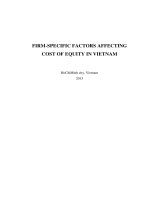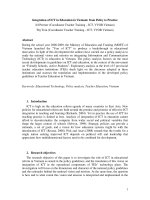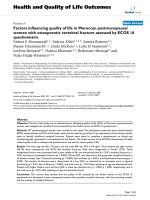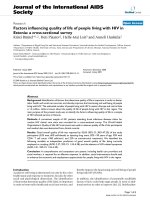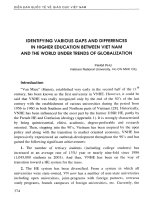Factors Influencing Integration of ICT in Higher Education in Vietnam
Bạn đang xem bản rút gọn của tài liệu. Xem và tải ngay bản đầy đủ của tài liệu tại đây (96.14 KB, 9 trang )
Factors Influencing Integration of ICT in Higher Education in Vietnam
Jef Peeraer
*
Flemish Association for Development Cooperation and Technical Assistance Vietnam
Thao Vien guesthouse A3 rm 307, 1B Bac Son - Ngoc Ha, Hanoi, Vietnam
Peter Van Petegem
University of Antwerp, Institution of Education and Information Sciences
Venusstraat 35, 2000 Antwerp, Belgium
Abstract: This study investigates the factors influencing integration of ICT in teacher education in
Vietnam, an emerging developing country, at the beginning of integration of ICT. Exploratory
multiple regression analysis addresses the importance of different factors at the teacher level and
the importance of the teacher education institute for the integration of ICT in teaching practice. The
use of ICT applications for teaching practice is limited, mostly replacing traditional teaching
practice. The factors explaining the integration of ICT in teaching practice are ICT skills and
computer confidence. Significant differences exist between different teacher education institutions.
Suggestions are made as to what approach to take to effectively integrate ICT in teacher education
in Vietnam.
Introduction
Integrating ICT in teaching and learning is high on the educational reform agenda. Often ICT is seen as
indispensable tool to fully participate in the knowledge society. ICTs need to be seen as “an essential aspect of
teaching’s cultural toolkit in the twenty-first century, affording new and transformative models of development that
extend the nature and reach of teacher learning wherever it takes place” (Leach, 2005). For developing countries like
Vietnam, ICT can moreover be seen as a way to merge into a globalizing world. In the school year 2008-2009 the
Vietnamese Ministry of Education and Training (MOET) launched the year of ICT in education. ICT is
conceptualized as a tool that can effectively support the innovation of teaching, learning and education management,
and that contributes to improve efficiency and quality of education (MOET, 2008). Educators in Vietnam are
encouraged to reasonably implement ICT applications in new and innovative methods of teaching and learning at
each grade (MOET, 2008).
A study took place, addressing factors influencing or constraining the uptake of ICT of teacher educators of
five teacher education institutes in five provinces in the middle and the North of Vietnam. This research paper
reports on the baseline situation of the teacher education institutions in the beginning of the school year 2008-2009,
at the start of ‘The Year of ICT’.
Conceptual Framework
An Educational Reform Agenda
Although countries are at the beginning of using new technology, its future use in education cannot be
underestimated (Carnoy & Rhoten, 2002). It is assumed that ICT brings revolutionary change in teaching
methodologies. The innovation lies not per se in the introduction and use of ICT, but in its role as a contributor
towards a student-centered form of teaching and learning (Scrimshaw, 2004). John and Sutherland (2005) warn to be
cautious though when speaking of the affordances of new technologies and when assuming that a given medium or
technology will automatically afford particular learning outcomes. In reality, learning is always distributed in some
*
Corresponding author, tel: +84 (0) 909 824 889, fax: +84 (4) 734 72 90
form between the technology, the learner and the context and there is nothing inherent in technology that
automatically guarantees learning. More and more critical voices are raised in the West and recently two
observations temper expectations: first there has been a disappointingly slow uptake of ICT in education even
though high investments have taken place in improving access to technologies and improving skills of teachers and
learners; secondly there doesn’t seem to have taken place an educational revolution in teaching and learning
(Selwyn, 2007). So far, computers have not transformed teaching practices (Becker, 2000). Researchers as Kirkup
and Kirkwood (2005) indicate an abundance of computers and technological infrastructure in higher education
institutions. In campus- based contexts, teaching staff learn to use those technologies which they can incorporate
into their teaching activity that offer affordances for what they already do most easily, rather than those which
radically change teaching and learning practices (Kirkup & Kirkwood, 2005).
A Model of Influencing Factors for the Use of ICT for Teaching Practice
Influencing or constraining factors to the integration of ICT in teaching practice can be categorized in
different ways. In a framework addressing challenges to classroom technology use, Groff & Mouza (2008)
distinguish several critical factors going from legislative, district/school level factors over factors associated with the
students and the teachers to factors inherent to the technology itself and factors associated with the technology-
enhanced project. .Mumtaz (2000) distinguishes three interlocking factors: institution, resources and teacher. Ten
Brummelhuis (in Drent & Meelissen, 2008) categorizes influencing factors in factors which can be manipulated and
factors which are not manipulative. At the school level, important contextual factors are socio-cultural setting of a
school and structural characteristics like government ICT policy, ICT infrastructure and school type. At teacher
level, two types of barriers are common; external or first-order barriers, such as limited resources or lack of
technical support, and internal or second-order barriers, which include teachers’ attitudes to ICT (Snoeyink and
Ertmer in Jones, 2004).
Teach er
Education
Institu te
(Provin ce)
Sex
Age
Main Subject
Teaching
Access to
computers
ICT confidence
ICT skills
Intensity of
Computer Use
Conceptions of
student learning
Attitudes
towards ICT
Use of ICT
for Teaching
Practice
Figure 1: Model of Influencing Factors for the Use of ICT for Teaching Practice
Figure 1 describes our research model, based on literature and experience in integration of ICT in education
in Vietnam. Use of ICT in teaching practice is the dependent variable. Non-manipulative factors are gender, age and
subject teaching. Influencing first-order manipulative factors are access to ICT, intensity of use, confidence and
skills. Of a different, internal order, are perceived values of ICT and conceptions of student learning. Province will
give an indication of the additional influence of contextual factors at the level of the teacher education institution. In
what follows we draw the theoretical background, reflecting on the barriers of access, confidence and skills, on
digital divides and on the role of attitudes towards ICT and educational beliefs for the integration of ICT in teaching
practice.
Access, Confidence and Skills
Mumtaz (2000) points out that a lack of computers and software can seriously limit what teachers can do in
the classroom with regards to integration of ICT. Access to ICT is a first and necessary step in the integration
process even though mere access will not automatically lead to use of ICT for teaching and learning. According to
Campbell (Alampay, 2006) the digital divide refers to “situations in which there is a marked gap in access to or use
of ICT devices”. Another crucial barrier to the integration of ICT is ICT competence or skills and ICT confidence. A
very significant determinant of teachers’ levels of engagement in ICT is their level of confidence in using the
technologies. Teachers who have little or no confidence in using computers in their work will try to avoid them
altogether (Dawes, 2000; Larner and Timberlake, 1995; Russell and Bradly, 1997 in Jones, 2004). Jones’ review
demonstrates that there are close relationships between barriers to the integration of ICT. Lack of personal access,
technical problems or lack of teacher competence can lead to lack of teacher confidence, but in turn, a lack of
confidence could itself magnify the effects of these three barriers (Jones, 2004).
Digital Divides
Individual differences between educators influence access to ICT, use, confidence and skills (Jones, 2004).
Often non-manipulative factors at the level of the teacher like age and gender are described (Cooper, 2006;
Meelissen & Drent, 2008; Prensky, 2001; Todman & Day, 2006). Computer anxiety is often highlighted as the
fundamental problem behind the digital gender divide (Cooper, 2006; Todman, 2006). However, there are
contradictions in research about the influence of gender on the use of ICT and even the very notion that there is a
gender problem is problematised (Abbiss, 2008). Also age can influence the uptake of ICT for teaching (Jones,
2004). Prensky (2001) distinguishes between ICT natives, who are born in a digital world, and digital immigrants
who have to learn the digital language and for whom ICT will always be a second language. Apart from gender and
age, the teachers’ subject domain may influence the use of ICT. John (2005) argues that school subject cultures are
built on deep traditions and that these need to be addressed if ICT is to become more embedded in the curriculum of
schools. The way ICT is used in lessons is influenced by the teachers’ knowledge about their subject and how ICT is
related to it (Cox et al., 2003).
Educational Beliefs and Attitudes Towards ICT
At the core of effective integration of ICT in teaching and learning, lie capacities which go beyond mere
access and ICT literacy. There is little point in providing large quantities of equipment if teachers do not have the
attitudes necessary to change their classroom practices (Ertmer in Jones, 2004). In the West, many researchers move
from investigating environmental barriers of access to individual teacher characteristics like beliefs and attitudes
(Hermans, Tondeur, van Braak, & Valcke, 2008; Mueller, Wood, Willoughby, Ross, & Specht, 2008). One key area
of teachers’ attitudes towards ICT is their understanding of how it will benefit their work and their students’ learning
(Jones, 2004). Cox (2008) expresses the need to measure, among other factors, the teachers’ beliefs and
understanding of the role of IT within the subject being taught. Kirkup & Kirkwood (2005)distinguish innovators
who are enthusiastic for the technology as valuable itself, and later adopters who are less interested in the
technology and need evidence that it will improve their lives or work. Hermans et al. (2008) shed light on the
mediating role of teachers’ educational beliefs in the resistance and receptiveness to integrate computers in
classroom practice. Mumtaz (2000) concludes in a meta-analysis that teachers’ theories about teaching are central in
influencing teachers to use ICT in their teaching. Teachers’ educational beliefs can be barriers to ICT integration
(Ertmer in Hermans et al., 2008). Becker (in Hermans et al., 2008) suggests on the other hand that highly active
computer users seem to adopt a constructivist position. Findings have been inconsistent though (Chen, 2008;
Mueller et al., 2008). Positive attitudes towards ICT or constructivist perspectives on learning will not automatically
lead to the uptake of ICT or innovative teaching practice. Judson (2006) suggests that there may be little correlation
between stated beliefs and actual practice.
Research Aims
In the first place we want to describe to what extent ICT is integrated in teacher education in an emerging
developing country, by assessing to what extent ICT is used in teaching practice. Apart from that we want to
estimate the importance of external and internal manipulative factors for the integration of ICT in teaching practice,
over the influence of non-manipulative factors of age and gender or main subject teaching.
Methodology
Data Collection and Participants
Data collection took place at the beginning of the school year 2008-2009 using a questionnaire presented to
a total of 863 teacher educators of 5 teacher education institutes in 5 provinces in the North and the middle of
Vietnam. The 5 institutes participate in a development cooperation program contributing to the education change
process towards Active Teaching and Learning through integration of ICT. The questionnaires were developed
based on literature research. They were translated into Vietnamese and back translated to English in order to check
for mistakes and misunderstandings due to cultural adaptations. Adaptations were discussed with Vietnamese ICT
experts. All staff members of the 5 teacher education institutions were invited to fill out the questionnaire. In total
783 questionnaires were filled out during plenary sessions in the 5 teacher education institutes, resulting in a
response rate of 91 %.
Statistical Analysis Approach
Descriptive analysis will draw a picture of the situation of teacher education institutes in Vietnam
concerning teacher educators’ use of ICT for teaching practice.
Exploratory multiple regression analysis will give an idea of the influence of the non-manipulative and
manipulative external and internal factors at the teacher level on the integration of ICT in teaching practice. A
hierarchy of sets of independent variables is formed and tests are done on the significance of increments to R
2
by
means of the F ratio. The hierarchy of sets is an important part of the investigator’s hypothesis statement (Cohen,
1968). The research objective of our study is to explore the importance of manipulative factors, over the influence of
non-manipulative factors. Therefore in the hierarchy of sets is started from non-manipulative variables on the
teacher level (set 1). These variables are expected to be relevant to the dependent variable, but should be controlled
for when measuring the contribution of manipulative teacher level factors. In the first place we want to assess the
importance of external manipulative factors (set 2) after which we want to assess the net influence of the internal
manipulative factors (set 3). Apart from the factors on the teacher level, we finally want to reflect on the importance
of factors on the level of the institute (set 4).
Results
Used Scales and Reliability
A set of instruments were developed, based on existing scales, to measure the described manipulative
factors and dependent variable. Reliability of the instruments was examined using Cronbach’s alpha when
applicable. Most instruments show satisfactory internal consistency, except for the scale on conceptions of ‘student
learning as intake of knowledge’. All reliable scales were used for the multiple regression analysis.
N
α
Computer skills
19
.951
Basic computer skills
7
.859
Internet skills
7
.909
Maintena
nce and security skills
5
.842
Computer confidence
7
.801
Cognitiv
e attitudes towards ICT
15
.724
Conceptions of Learning:
Learnin
g as intake of kno
wledge
9
.523
Conceptions of Learning:
Learning as construction of knowle
dge
8
.710
Use of I
CT for teaching practice
7
.869
Table 1: Reliability Coefficients Scales
Use of ICT Applications for Teaching Practice
Most teacher educators don’t use many ICT applications intensively (see table 2). 57.6 % never or rarely
uses subject specific software for integration into lesson practice, 65.3 % never or rarely uses electronic
communication tools like e-mail for communication with students, and 86.0 % never or rarely uses classroom
management software. The picture is different for other applications like word processing software and presentation
software where respectively 73.7 % and 55.0 % of teacher educators using these applications on a more regular basis
(sometimes or regularly). 57.4 % sometimes or regularly accesses information through a CD-ROM or DVD and
73.6 % sometimes or regularly uses the internet as source of information.
M
SD
Never
(%)
Rarely (%)
Sometimes
(%)
Regularly (%)
Production o
f documents
1.95
.909
8.9
17.4
43.9
29.8
Presentation
1.48
1.030
23.7
21.3
38.2
16.8
Integration into specific subjects
1.19
1.037
34.8
22.8
31.2
11.2
Access offline information
1.55
.975
18.8
23.8
41.1
16.3
Electronic communication
1.01
1.059
44.3
21.
0
23.6
11.0
Access online information
1.88
.971
13.7
12.7
45.5
28.1
Classroom management
.47
.850
72.1
13.9
9.2
4.8
Table 2: Descriptive Statistics of the ‘Use of ICT for Teaching Practice Scale’
Correlation analysis shows strong and significant correlations (with p < 0.05) between the use of different
ICT applications for teaching practice.
Influence of Non-Manipulative and External and Internal Manipulative Factors
Hierarchical multiple regression analysis results in 4 models which each significantly explain a proportion
of variance in the use of ICT applications for teaching practice. Non-manipulative factors at the teacher level alone
explain 16.1 % of the variance. Women tend to a more limited use of ICT for teaching practice than men and age
has a negative influence on intensity and diversity. The influence of gender, age and subject teaching loses
significance though after entering external manipulative factors of access to ICT, intensity of use, ICT skills and
confidence. It is remarkable that use of the computer for working purposes positively contributes to the use of
applications for teaching practice (β = 0.173), but that ICT use in general has significant negative influence on the
use of ICT for teaching practice (β = -0.129). Access to a personal computer in the institute negatively influences the
uptake of ICT for teaching practice. ICT skills is a strong influencing factor (β = 0.499) and together with computer
confidence (β = 0.164), these factors remain significant after adding other variables to the model.
Internal factors like attitude towards computers and conceptions of student learning as construction of
knowledge do not significantly influence the use of ICT applications for teaching practice. Model 3 does not
significantly differ from model 2 in explained variance. Finally the dummy variables representing the different
institutes significantly increase the explained variance, indicating that apart from the aforementioned factors on the
teacher level, the teacher education institute influences the uptake of ICT for teaching practice significantly. The
final model explains 58.1 % of variance in the dependent variable. The factor contributing the most to the explained
variance in the final model remains ICT skills and computer confidence, with a standardized beta coefficient of 0.52
and 0.158 respectively.
Model 1 Model 2 Model 3 Model 4
Non
-
manipulative factors
Gender (female)
187
***
n.s.
n.s.
n.s.
Age
311
***
n.s.
n.s.
n.s.
Natural science
.141
**
n.s.
n.s.
n.s.
Social sciences
n.s.
n.s.
n.s.
n.s.
English
n.s.
n.s.
n.s.
n.s.
Vietnamese language
n.s.
n.s.
n.s.
n.s
.
Educational sciences
n.s.
n.s.
n.s.
n.s.
ICT/technology
.233
***
n.s.
n.s.
n.s.
Mathematics
.098
*
n.s. n.s. n.s.
Manipulative, external factors
Internet access at home and in TEI
-
n.s.
n.s.
n.s.
Internet access at home only
-
n.s.
n.s.
n.s.
Internet access TEI only
-
n.s.
n.s.
n.s.
Personal access computer at home
-
n.s.
n.s.
n.s.
Personal access computer TEI
- 084
*
086
*
099
**
Computer use general
- 129
*
125
*
n.s.
Computer use for work
- .173
**
.172
**
.138
*
Intensity in
ternet use
- n.s. n.s. n.s.
ICT skills
- .499
***
.503
***
.522
***
Computer confidence
- .164
**
.160
**
.158
***
Manipulative, internal factors
Attitude towards computers
- -
n.s.
n.s.
Student learning as construction
- -
n.s.
n.s.
Contextual factors
Province 1
- - -
n.s.
Province 2
- - - 185
***
Province 3
- - -
n.s.
Province 4
- - -
n.s.
Adjusted R
2
‘Use of ICT in teaching practice’
.161 .555 .553 .581
F change
10.579 39.880 .316 8.115
df1
9 10 2 4
sig. F change
.000 .000 .730 .000
Note. – not included in model, n.s. not significant,
*
p<.05,
**
p<.01,
***
p<.001.
Table 4: Factors Influencing the Use of ICT for Teaching Practice: Standardized Regression Coefficients,
Proportion of Explained Variance and F Change
Conclusions and Discussion
For most teacher educators in the 5 teacher education institutions in the Northern and the Central Vietnam,
access is not a barrier to the use of ICT for teaching practice. Personal access to a computer in the teacher education
institute results in a lower use of ICT for teaching practice though (β = 099). It can be assumed that this personal
access is for other purposes than use in classroom practice. As described in other research it could be that many
teachers own and use computers for their own administrative work, but never use them in their classrooms (Watson,
2001). Capability theory (Alampay, 2006) instructs that deployment of ICT should always be informing about its
added value or the opportunities it creates.
It is mainly ICT skills of teacher educators (β = .522) and computer confidence (β = .158) which influences
whether or not ICT applications are used for teaching practice. Better skilled teacher educators tend to use more
diverse ICT applications and on a more regular basis than teacher educators who perceive lower ICT skills. As
described by Jones (2004) lack of competence goes together with lack of confidence and both factors are very
significant determinants for the uptake of ICT in teaching practice. There is a significant correlation (with p < 0.01)
of 0.576 between ICT skills and computer confidence.
Gender, age and subject teaching influence the integration of ICT in teaching practice. The younger teacher
educators can be seen as ICT natives (Prensky, 2001) who have been more exposed to ICT. The same applies for
teacher educators teaching subjects like technology and ICT, mathematics or natural sciences. This confirms the
importance of subject cultures (John, 2005) for the integration of ICT in education. There is no significant influence
of gender, age or subject teaching on the integration of ICT in teaching practice, over the variance explained by ICT
skills and computer confidence though.
There are high expectations concerning the added value of ICT, but these values have no influence on the
use of ICT for teaching practice (p > .05). Conceptions of teacher educators of student learning play no role in their
use of ICT for teaching practice (p > .05), indicating a gap between rhetoric and practice as described by Judson
(2006). Richards (2004) points out that abstract ideas about learner-centered pedagogy, life-long education and
flexible learning are well known and even perhaps the theoretical orthodoxy today in many Asian countries. But
Richards also observes that “… despite the attraction and obvious relevance of ‘new learning’ theories and policy, it
is not easy in practice to give up or change the traditional habits of hierarchical organization and transmission model
of the authoritative teacher-passive student relations” (p. 342).
Vietnamese teacher educators mostly use ICT in teaching practice in a way it mainly replaces traditional
practice. Teacher educators sometimes or regularly use word processing software for production of documents (73.7
%), presentation software is used for lecturing or they use ICT to access information. When it comes to more
advanced, subject specific applications or electronic communication, which could activate students in the learning
process, use of ICT remains low. Similar results are found in research on the use of ICT by teacher mentors. Cuckle
and Clarke (2002) found that their respondents used a range of ICT applications for lesson preparation, but that these
applications were much less used in classroom teaching. Gülbahar (2007) describes teachers who feel competent in
using ICT available in the school, but no successful integration in the classroom is taking place. Mills and Tincher
(2003) describe pervasive use of computers by teachers in preparation for instruction, but limited use of computers
by teachers for delivering instruction and integrating technology in the classroom. There are strong and significant
correlations between the use of different ICT applications for teaching practice (from .226 to .650). This indicates
that there are some Vietnamese teacher educators who are ICT minded, enthusiasts or innovators, in the sense
described by Kirkup & Kirkwood (2005). These educators apply their skills in their teaching practice, while there
are teacher educators who don’t use ICT in any way for teaching practice. Teachers who could not be considered
‘innovators’ or ‘early adopters’ are unlikely to be adventurous in their use of ICT; instead they will use the
technology to replicate or supplement existing teaching practices. Such uses do not require teachers to rethink their
teaching practices or reconsider their understanding of student learning (Laurillard in Kirkup & Kirkwood, 2005).
There are differences between respondents from different teacher education institutes and probably context variables
like ICT policies, budget and educational management play a role in the integration process of ICT.
Methodologically multilevel models have to be developed to explore how these factors of the school level contribute
to integration of ICT in education (Wong & Li, 2008).
As described by Selwyn (2007) for the West, also no educational revolution is taking place yet in Vietnam.
Vietnam is at the beginning of integrating ICT in education and lessons can be learnt from research in the West.
Integration of ICT in education is a slow process and observations bring to light a certain path or steps which are
taken in the process. Researchers emphasize the notion of change as a staged process (Tearle, 2003). In the first
place often investments are made in technology and skills training and ICT is seen as an object of education. ICT as
object of education refers to learning about ICT and the acquisition of ICT skills: teachers and learners have to know
how to work with the medium, the technology and therefore have to acquire the necessary skills to become ICT
literate. When having a closer look at lack of teacher confidence though, research shows that this may be caused by
lack of ‘self training’, lack of skills training as well as lack of pedagogical training. Even though an element of ICT
skills training is necessary (Preston et al. in Jones, 2004), courses which lack pedagogical aspects are likely to be
unsuccessful (Veen in Jones, 2004).
The present study does not offer the answer to successful integration of ICT in education. It is clear that
important conditions for successful integration are met in Vietnam. At this stage, access is no longer the main factor,
even though personal access and access to teaching technology could still make a difference. Further research on the
importance of availability of equipment for teaching practice is necessary. Skills training is still important. Vietnam
could make a difference though and aim to go beyond a limited, skills-based approach, striving for integration of
ICT in education as a tool for active teaching and learning. It is clear that Vietnamese teacher educators are very
much aware of the potentials of ICT and they are open for constructivist approaches of teaching and learning. At the
same time as improving access and training skills, Vietnamese teachers and teacher educators should be prepared for
a changed teacher role and should know how ICT can be used in a way it improves the learning process towards
active teaching and learning.
References
Abbiss, J. (2008). Rethinking the 'problem' of gender and IT schooling: discourses in literature.
Gender & Education, 20(2), 153-165.
Alampay, E. A. (2006). Beyond access to ICTs: Measuring capabilities in the information
society. International Journal of Education and Development using Information and
Communication Technology (IJEDICT), 2(3), 4-22.
Becker, H. J. (2000). Findings from the Teaching, Learning, and Computing Survey: Is Larry
Cuban Right? Education Policy Analysis Archives, 8(51).
Carnoy, M., & Rhoten, D. (2002). What Does Globalization Mean for Educational Change? A
Comparative Approach. Comparative Education Review, 46(1), 1.
Chen, C H. (2008). Why Do Teachers Not Practice What They Believe Regarding Technology
Integration? Journal of Educational Research, 102(1), 65-75.
Cohen, J. (1968). Multiple regression as a general data-analytic system. . Psychological Bulletin,
70(6), 426-443.
Cooper, J. (2006). The digital divide: the special case of gender. Journal of Computer Assisted
Learning, 22(5), 320-334.
Cox, M. J. (2008). Researching IT in Education. In J. Voogt & G. Knezek (Eds.), International
Handbook of Information Technology in Primary and Secondary Education (Vol. 20, pp.
965-981): Springer US.
Cox, M. J., Webb, M., Abbott, C., Blakeley, B., Beauchamp, T., & Rhodes, V. (2003). ICT and
pedagogy – a review of the research literature. London: BECTA/DfES.
Cuckle, P., & Clarke, S. (2002). Mentoring student-teachers in schools: views, practices and
access to ICT. Journal of Computer Assisted Learning, 18(3), 330-340.
Drent, M., & Meelissen, M. (2008). Which factors obstruct or stimulate teacher educators to use
ICT innovatively? Computers & Education, 51(1), 187-199.
Gülbahar, Y. (2007). Technology planning: A roadmap to successful technology integration in
schools. Computers & Education, 49(4), 943-956.
Hermans, R., Tondeur, J., van Braak, J., & Valcke, M. (2008). The impact of primary school
teachers' educational beliefs on the classroom use of computers. Computers & Education,
51(4), 1499-1509.
John, P. (2005). The sacred and the profane: subject sub-culture, pedagogical practice and
teachers' perceptions of the classroom uses of ICT. Educational Review, 57(4), 471-490.
John, P., & Sutherland, R. (2005). Affordance, opportunity and the pedagogical implications of
ICT. Educational Review, 57(4), 405-413.
Jones, A. (2004). A review of the research literature on barriers to the uptake of ICT by
teachers: British Educational Communications and Technology Agency (Becta).
Judson, E. (2006). How teachers integrate technology and their beliefs about learning: is there a
connection? Journal of Technology and Teacher Education, 14, 581-597.
Kirkup, G., & Kirkwood, A. (2005). Information and communications technologies (ICT) in
higher education teaching”a tale of gradualism rather than revolution. Learning, Media,
& Technology, 30(2), 185-199.
Leach, J. (2005). Do new information and communication technologies have a role to play in
achieving quality professional development for teachers in the global south? 1.
Curriculum Journal, 16(3), 293-329.
Meelissen, M. R. M., & Drent, M. (2008). Gender differences in computer attitudes: Does the
school matter? Computers in Human Behavior, 24(3), 969-985.
Mills, S. C., & Tincher, R. C. (2003). Be the Technology: A Developmental Model for
Evaluating Technology Integration. Journal of Research on Technology in Education,
35(3), 382.
MOET. (2008). Directive on Promoting Teaching, Training and Applying ICT in Education -
Period 2008-2012 (55/2008/CT-BGDðT).
Mueller, J., Wood, E., Willoughby, T., Ross, C., & Specht, J. (2008). Identifying discriminating
variables between teachers who fully integrate computers and teachers with limited
integration. Computers & Education, 51(4), 1523-1537.
Mumtaz, S. (2000). Factors Affecting Teachers' Use of Information and Communications
Technology: a review of the literature. Journal of Information Technology for Teacher
Education, 9(3), 319-342.
Prensky, M. (2001). Digital natives, digital immigrants. On the Horizon, 9(5), 1-2.
Scrimshaw, P. (Ed.). (2004). Enabling teachers to make successful use of ICT: Coventry: British
Educational Communications and Technology Agency.
Selwyn, N. (2007). The use of computer technology in university teaching and learning: a critical
perspective. Journal of Computer Assisted Learning, 23(2), 83-94.
Tearle, P. (2003). ICT implementation: what makes the difference? British Journal of
Educational Technology, 34(5), 567-583.
Todman, J., & Day, K. (2006). Computer anxiety: the role of psychological gender. Computers
in Human Behavior, 22(5), 856-869.
Watson, D. M. (2001). Pedagogy before Technology: Re-thinking the Relationship between ICT
and Teaching. Education and Information Technologies, 6(4), 251-266.
Wong, E. M. L., & Li, S. C. (2008). Framing ICT implementation in a context of educational
change: a multilevel analysis. School Effectiveness and School Improvement, 19(1), 99 -
120.
